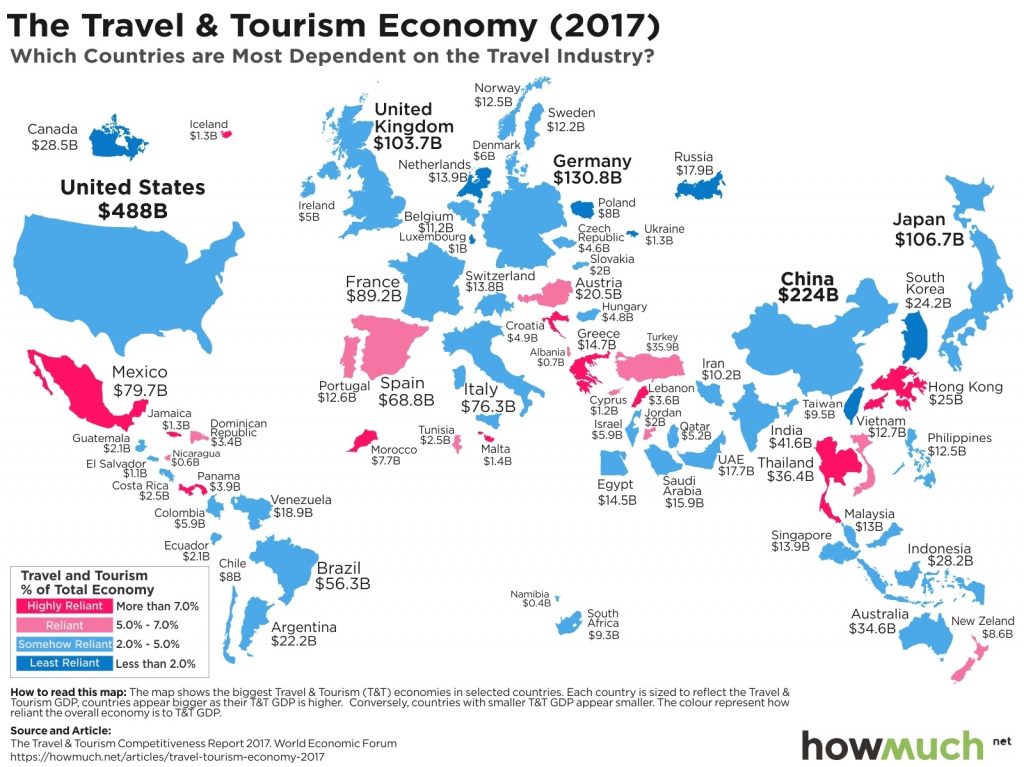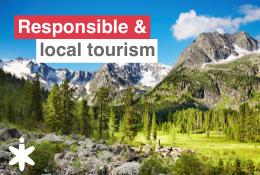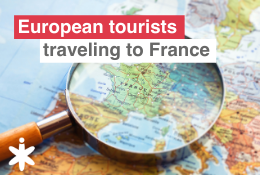This made us think about…
The weight of tourism industry in destinations’ GDP
This made us think about… – The weight of tourism industry in destinations’ GDP

Story – Chile workshop & partners
2 May 2017
Brand content: now is the time to think video!
19 June 2017This made us think about… – The weight of tourism industry in destinations’ GDP

A growing industry…
According to the UNWTO barometer, international tourist arrivals increased by 3.9% in 2016 vs previous year, and reached 1,235 million. A regular and uninterrupted increase since 2009 crisis, to compare with the 25 million tourists in 1950 and the 935 million in 2010!
With an average annual growth of over 15 million tourists, international tourism is one of the fastest-growing industry, reaching USD 1260 billion in 2015, and 10,2% of global GDP.

From World Economic Forum data, a map was published at the end of April 2017 showing the share of tourism in 70 countries GDP, from the USA to Vietnam, and from Austria to Namibia. It appears that the most dependent country on the tourism industry is Malta, since with USD 1.4 billion, it represents more than 15% of national GDP!
The top 5 also gathers Croatia (USD 4.9 billion, or 10% of GDP), Thailand (USD 36.4 billion, 9,3%), Jamaica (USD 1.2 billion, 8,9%) and Iceland (USD 1.3 billion, 8,2%).
In the countries with the largest tourism industries (USA comes first with USD 488 billion, followed by China with 224, Germany 130, Japan 106 and UK 103), the GDP share is between 2,1 and 3,9%. France comes in 6th position with USD 89.2 billion (3,7%).
… but at different levels.
When comparing those figures with the report published in 2011 (with 2010 figures), we can see that the growth varies according to each country. Malta won more than 5 points between 2010 and 2016, when at the same time, Croatia, USA or Japan declined, both in the absolute value and in the GDP share.
The main thing to remind is that, except with those exceptions we just mentioned, the share of tourism industry in GDPs remains quite stable, despite strong increases like for China, which went in 2010 from USD 113 billion to 224 in 2016, but a similar 2,1% of national GDP.
************
The international tourism industry cake keeps growing each year…
Each destination has its own history in tourism, and some countries clearly were pioneers, welcoming mass tourism for years and years. It’s easy and tempting to think that tourists will always come and come again, without trying to renew the destination’s image, create new products or promote new visit places. But the danger is here: every year, new destinations get in the promotion market.
50 years ago, a small number of countries sent tourists in a small number of destinations.
25 years ago, a small number of countries sent tourists in a large number of destinations.
Today, a large number of countries send tourists in a large number of destinations.
Tomorrow, all the countries will send tourists in all the destinations.
… and more and more countries want a slide of it!
The traveler has always more choices, and destinations unknown for their tourism now try to catch up. They have realized that concentrating a national economy in a limited number of industries was very risky in case of a crisis.

Bahrain – Isa Bin Ali House
That’s how, those last years, countries like Bahrain or Qatar are taking measures to diversify their economy, so as not to rely only on energy. Other destinations try to open as much as possible the profile of their tourists, and take advantage of the international flows of travelers. We can give the example of Singapore, trying to leverage as a high value destination for a few days stopover to extend travelers’ journey to Asia or Australia.
But of course « new » destinations aren’t the only ones to try to increase their market shares, and lots of « historical » destinations want to avoid the risk of inertia, which inevitably leads to a drop in arrivals, and therefore in revenues.
After few years of mixed results, Canadian province of Quebec decided to get a clear positioning for a multi-targeted public, highlighting very diverse experiences according to the travel season. Lisbon city, which became throughout the years a trendy destination, defined a diversification strategy, promoting new angles to make discover the richness of the Portuguese capital, beyond the traditional city breaks, to encourage repeater tourists to come back again and again.
************
Tourism, a heavyweight in national economies… and jobs!
If many destinations have realized the potential of tourism industry in their national economy (and as a consequence on jobs), we still can deplore that some regions (Africa is an example) are lagged.
It’s all the more regrettable that, even if it can’t solve all the world’s problem, and as President of the European Travel Commission Peter De Wilde declared: « Tourism is a Tool for Tolerance, And We Need More Of That! »

Copyright: Carbonneau Pierre

 All news
All news  Back to the newsroom
Back to the newsroom


